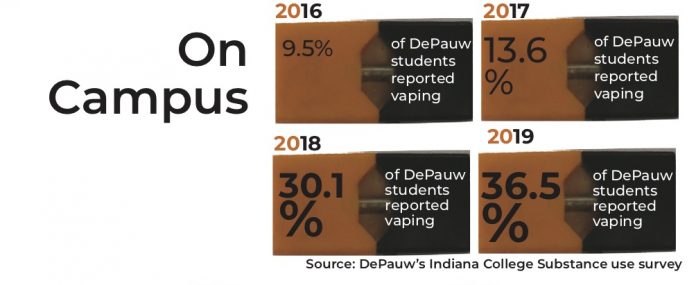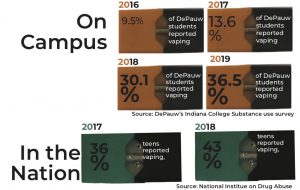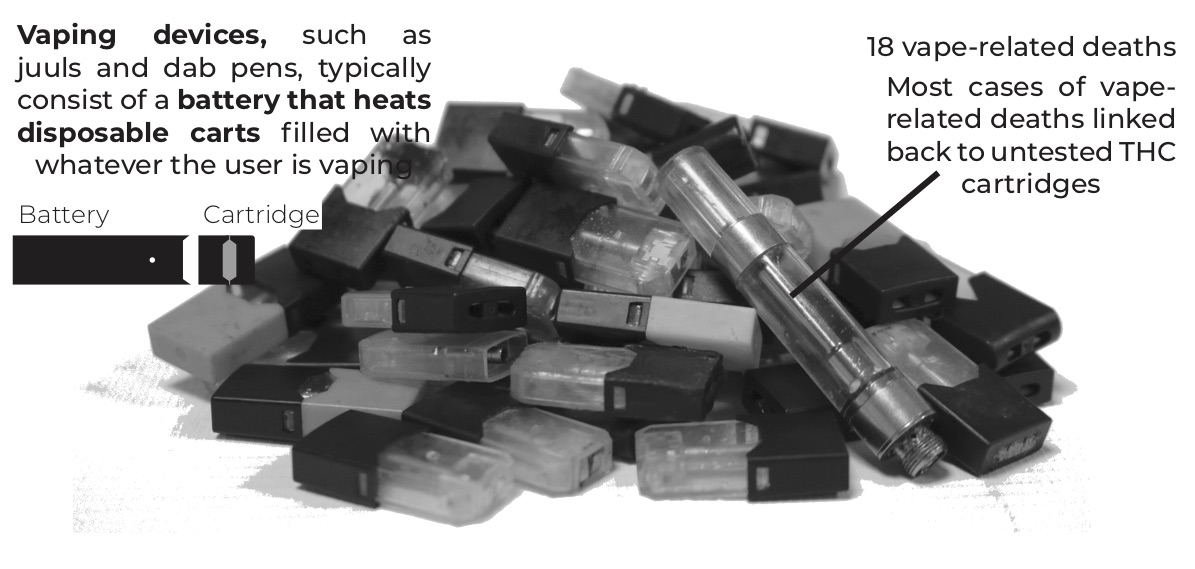

Since 2016, vaping on DePauw’s campus has quadrupled from 9% to 36% according to the DePauw data set of the 2019 Indiana College Substance Use Survey. Of the 36% who are vaping, 86% reported vaping nicotine and 64% used THC devices.
In 2018, 37.3% of 12th graders reported using any sort of vaping—comparable to DePauw’s vape use—according to the National Institute on Drug Abuse.
There have been no reported vape-related illnesses on DePauw’s campus to date, but nationwide, it’s a different story.
As of Oct. 4, 18 people in the U.S. have died from vape-related injuries with 80% of victims under age 35, according to the Center for Disease Control (CDC). Vaping has taken center stage in the national media and research spotlight with thousands of confirmed cases of vape-related injuries in the U.S.
Some colleges, such as Indiana University, have already banned vaping in their tobacco-free policies. DePauw, however, allows smoking within 40 feet of university buildings and residence halls, but has no statement about vaping-devices.
Julia Sutherlin, assistant dean of campus life and director of the office of substance abuse prevention and education, has created a new team of faculty, staff and students to tackle issues of alcohol and substance abuse on campus this year called the DePauw Collaborative.
Sutherlin has most recently been working with this group to review campus smoking policies, which have not been reviewed since 2008.
The DePauw Collaborative, along with Dr. David Harsha and counselor, Becky Roberts, will hold an open conversation on vaping on Thursday, Oct. 24th from 12-12:45 p.m., location TBD. The event is open to all.
“We are trying to get a very broad representation of our campus community to review our smoking policy because a) our smoking policy is 10 years old, so it's time to review it. And b) the only place where there is a smoking policy is…in the employee handbook and the resident student handbook,” Sutherlin said.
The student handbook, however, does not mention smoking or vaping, and Sutherlin wants it to be addressed.
After vape usage increased from 2017-2018, flavor bans were put in place late-2018. From 2017 to 2018, teens who reported vaping in their lifetime rose from roughly 36% to 43% according to the National Institute on Drug Abuse.
E-cigarettes have existed since the early 2000s according to Medical News Today. Initially developed with the intention of helping people addicted to cigarettes, vaping has since spread to use in cannabis products.
Though less research is available on THC-vaping products, such as dab pens, the National Institute on Drug Abuse reports a massive growth in their usage.

While teens are more likely to use vapes instead of cigarettes according to the National Institute on Drug Abuse, some students use vaping as a way to quit cigarettes.
“I started juuling because I got into cigarettes because of my family, and I knew that was bad for me so I wanted to quit,” first-year Will Cole said. “I don’t think anybody thinks juuling is good for you. Like there’s nobody who hits it and is like ‘Ah, this tastes like fruit so it must be good for me.’ But Juuls were made to get people to stop smoking.”
Cole plans to quit juuling at some point.
Sophomore Rafael Martinez started smoking cigarettes in high school before switching to vaping because he saw it as a healthier alternative. However, he switched back to cigarettes after the recent flavoring bans that made Juul pods harder to purchase and more expensive.
“I feel like the banning is only going to affect things in a more negative way, especially because you have these people who started on Juul and got addicted, but now have no access to it,” Martinez said. “And like, the only way they're going to get access to their cravings is if they move to cigarettes.”
A typical pack of four Juul pods costs around $18 a piece, while the average price for a pack of cigarettes in Indiana is $5.50 according to tobaccofreekids.com.
According to Juul’s website, one Juul pod has a nicotine content equivalent to one pack of cigarettes. Juul pods can be bought at either 5% or 3% nicotine, whereas a cigarette contains roughly 1.5% nicotine, according to the National Center for Biotechnical Information. Despite the higher nicotine and lower price, Juul pods don’t last as long as cigarettes according to users.
“Some people I know go through around two pods a day. I think that is because you don’t have to go outside to rip your Juul,” said junior Raj Kumar.
The CDC warns e-cigarette users not to switch to smoking combustible cigarettes, noting that cigarettes are much more dangerous than their electric counterparts. According to the CDC, over 480,000 deaths in the US are related to smoking cigarettes.
Just because vaping may be safer, does not mean it is safe.
“The worry right now is that there’s a lot of unknowns,” David Hersha, DePauw health medical director stated. “But we know that any tobacco product, of which e-cigarettes are, are harmful to the lungs,” Harsha said.
While there is no actual tobacco in e-cigarettes, nicotine salts used in the vape juice are derived from tobacco leaves, according to the American Academy of Family Physicians.
Senior Anna Pearson is currently conducting research on the effects of vaping on zebrafish.
The results of her research, which she began this summer, are still inconclusive.
“I think with a lot of students, the fact that we don’t know anything still is scary enough, whereas with drinking, you know what you’re putting in your body and what you’re signing up for,” Pearson said.
As inconclusive as the information is on e-cigarettes, even less is known about THC devices. In all 18 of the vaping-related deaths, illegal THC cartridges seemed to be the main factor, according to the CDC.

Many black market THC carts are cut with harmful additives in order to reach desired consistency or reduce cost of products, according to reputable cannabis-industry leader, leafly.com. Vitamin E acetate, which is one of those solvents, was found in a majority of the illegal cartridges tested by the New York State Department of Health.
Not all THC cartridges contain these solvents, however, according to Emily McCarter, ‘17.
McCarter is a social media content creator running a popular weed-friendly Instagram account called @mccartergetshigh. She is also a cannabis advocate in Colorado who has experience with the rise of vaping devices in the cannabis industry.
“You need to know the sources and what solvents were used in making [the cartridges],” McCarter said. “The news is just talking about vaping, but what type of vaping are you talking about? What chemicals are you vaping? What temperature is it at? What device are you using?”
While there’s no way to tell what is in an untested cart, public experts say that tested, labeled cartridges with no additives are far more safe than illegal ones, according to the Boston Globe.
But in a state like Indiana, where marijuana is illegal, knowing what is in your vape is nearly impossible.
Even in states where cannabis is legal, there still appears to be risks in Tetrahydrocannabinol (THC) vaping products. In Colorado, a state known for its connection with the cannabis industry, cartridge and additive regulation is still constantly being updated and reviewed, according to the Denver Post.
Thirty-seven percent of students reported using marijuana in any form in the last year, with 23% of students using vape to consume THC, according to the DePauw data set of the 2019 Indiana College Substance Use Survey.
“When I use [THC carts] I'm like, ‘Ah, this might be a bad idea,’ but it’s not scary enough for me to stop altogether,” said one anonymous student.
Vaping THC may also be seen as a gateway into using marijuana for students, as it is more discreet than traditional forms of smoking marijuana.
“I first saw it as a safer way, especially for people to try out,” said a second anonymous student regarding THC cartridges.
The DePauw reporter Ian Brundige contributed to this report.


